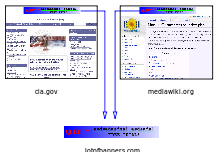웹사이트는 아주 작은 이미지(보통 1픽셀 크기의)를 사이트의 모든 페이지에 넣어 둡니다. 웹 비콘(web beacon)으로 알려진 이 이미지는 DoubleClick.com 에서 읽도록 되어 있었습니다. 브라우저가 사용자에게 보이기 위해 페이지를 만들어낼 때 DoubleClick.com 으로 그 이미지를 요청하게 됩니다. 이렇게 해서 더블클릭의 서버는 사용자가 요청한 페이지에 상관없이 자신의 쿠키를 읽을 수 있게 됩니다. 이런 트릭을 제3사 쿠기(third-party cookie)라 합니다.
출처: http://en.wikipedia.org/wiki/HTTP_cookie
Cookies have some important implications on the privacy and anonymity of Web users. While cookies are sent only to the server setting them or the server in the same Internet domain, a Web page may contain images or other components stored on servers in other domains. Cookies that are set during retrieval of these components are called third-party cookies. The standards for cookies, RFC 2109 and RFC 2965, specify that browsers should protect user privacy and not allow third-party cookies by default. But most browsers, such as Mozilla Firefox, Internet Explorer, Opera and Google Chrome do allow third-party cookies by default, as long as the third-party website has Compact Privacy Policy published.
Advertising companies use third-party cookies to track a user across multiple sites. In particular, an advertising company can track a user across all pages where it has placed advertising images or web bugs. Knowledge of the pages visited by a user allows the advertising company to target advertisements to the user's presumed preferences.
* Web bugs ( http://en.wikipedia.org/wiki/Web_bug )
A web bug is an object that is embedded in a web page or email and is usually invisible to the user but allows checking that a user has viewed the page or email.[1] One common use is in email tracking. Alternative names are web beacon, tracking bug, and tag or page tag. Common names for web bugs implemented through an embedded image include tracking pixel, pixel tag, 1×1 gif, and clear gif.[2]



 Rss Feed
Rss Feed